Note: This post contains affiliate links. As a Skillshare Affiliate and Amazon Associate I get commissions for purchases/signups made through links in this post.
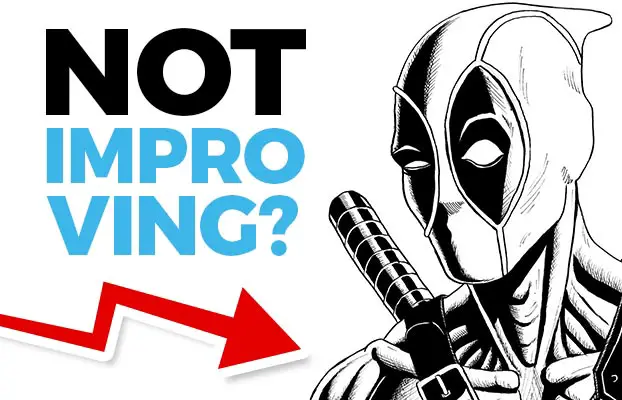
If you’re an artist – if you draw or paint regularly – you will probably at some point have felt like your art is not improving fast enough.
How do you get better faster?
The simple answer is, of course: Practice!
While it’s true, it’s somewhat of an oversimplification.
If you want to make the most of your time, if you want to learn drawing fast, you need to ask yourself what the most efficient way to practice drawing and painting is.
Because after all:
“Practice doesn’t make perfect. Perfect practice makes perfect.”
PREFER TO WATCH A VIDEO?
Here’s the first part of the article as a video:
Table of Contents
1. The Reasons Why Your Art Isn’t Improving Fast Enough
Your art isn’t improving fast enough because:
- You are not doing sufficient practice
- You are not challenging yourself
- You are not attacking your weak points
- You are expecting too much (too soon)
- You are getting emotional
» Learn Drawing FAST With This Course
1.1 You Are Not Doing Sufficient Practice
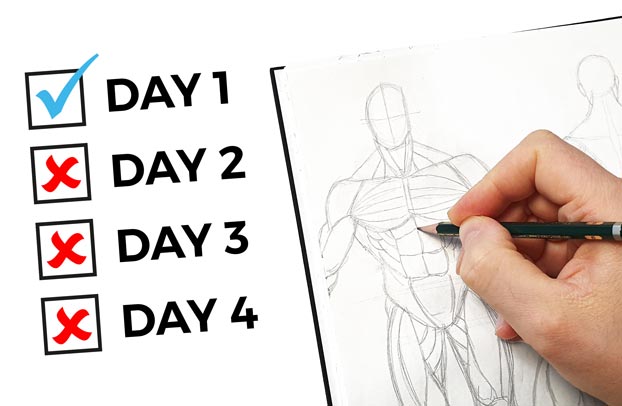
If you don’t practice often enough, your art won’t improve as fast as it could.
Reality Check:
Learning to draw doesn’t take hours or days. It takes years.
Successful artists don’t draw a couple of hours once a week. They do it almost every day. That’s commitment.
Be honest with yourself:
How much of your free time do you actually devote to drawing? An hour every day? Two hours every day on weekends? Or none at all?
The more you draw, the better you will get over time. Simple as that.
Of course, we are all human – you can’t draw 24/7.
But if you feel you aren’t improving fast enough, I urge you to look at how you are really spending your free time – and if you can’t devote a bit more of it to art.
And remember:
Consistency beats everything.
Drawing 15 minutes every day is better than 2 hours on weekends.
CHECK OUT: Must-have Art Equipment I Recommend
1.2 You Are Not Challenging Yourself
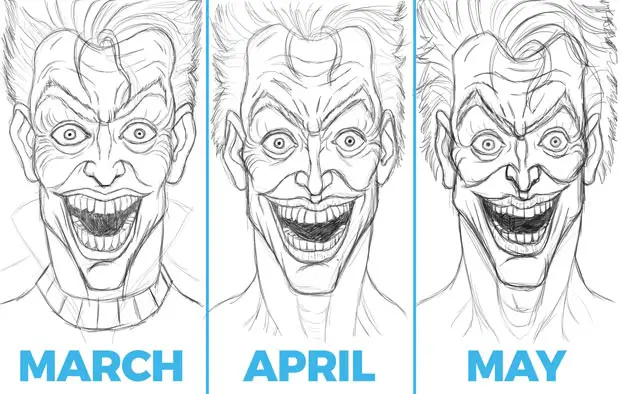
If you are not improving, maybe it’s because you are not pushing yourself.
We as humans are creatures of habit. And a lot of our habits aren’t really productive.
We often seek the path of least resistance.
Which in turn often leads to pleasure > productivity.
Why start a drawing session when you could just lie in bed watching some youtube videos? (Believe me, I know the struggle …)
Why draw something new when you could just draw what you already can?
After all, this way you already know the drawing will probably turn out great, right? (Believe me, I know this, too …)
You need to challenge yourself.
Drawing things you can’t already draw will be a struggle at first. But the reward of finally being able to draw something new (or better than before) will be worth it.
1.3 You Are Not Attacking Your Weak Points
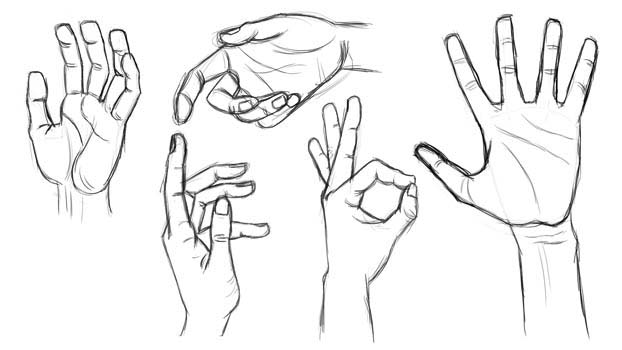
This one goes hand in hand with reason #2, but it goes one step further:
To improve faster, you need to tackle your flaws!
Practicing is great. The more you draw, the better you will get (with time). But practicing effectively is a different story.
If you really want to improve fast, consider actively working on your weak points.
Ask yourself: What can’t I draw?
Is it something specific? Hands? Feet? Cars? Cats?
Is it a certain aspect of drawing? Perspective? Proportions? Anatomy?
Whatever it is … attack it head-on!
You will learn more about how to learn drawing fast later in this article.
1.4 You Are Expecting Too Much (Too Soon)
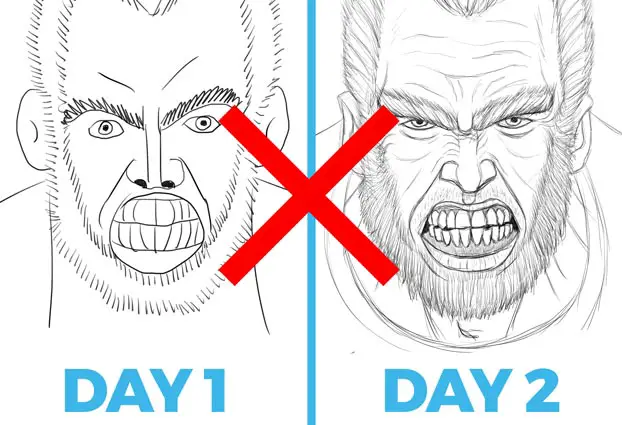
Learning to draw is a marathon, not a sprint.
With the right strategy you can make big jumps in progress quickly.
But even if you are doing everything right, if you are practicing perfectly every day, it will still take time to get really good.
I’m not talking about weeks or months … but years!
They say it takes 10,000 hours to become a master at something.
And even if that’s a very broad generalisation, consider the following calculation:
10,000 hours / 24 hours = 417 days
That’s 417 days, more than a year, of straight drawing. (No sleep!)
At 1 hour of practicing every day, it would take you 27.5 years.
Don’t get me wrong:
If you are dedicated, you can still become a good artist in a few years (or even months). But mastery requires year after year of focused practice.
Don’t get discouraged, if you are no David Finch yet, after 10 hours of practice. 🙂
Have some patience! Don’t quit too soon!
1.5 You Are Getting Emotional

What do emotions have to do with drawing? A lot.
If your art isn’t improving fast enough, your emotions might be a big reason why.
To improve your drawing fast, you need to be the master of your emotions.
What exactly does that mean?
It means you can’t let your emotions get the better of you.
Here are some examples of what can happen, if you do:
- You get frustrated because your drawing doesn’t turn out the way you wanted and quit too soon
- You procrastinate and defer practicing because you associate bad feelings with it
- You get overly happy when your drawing turns out great, but are all the more sad, if you can’t replicate this success in your next drawing
I believe the most successful people at drawing (or any other skill) are those who don’t let their emotions control every decision they make.
They think mostly rationally and don’t act on emotions all the time.
Therefore, a great drawing doesn’t make them too self-confident, but a few bad drawings don’t throw them off track either.
RELATED: Why You Can’t Draw Anymore (And What To Do About It)
2. How To Learn Drawing Fast
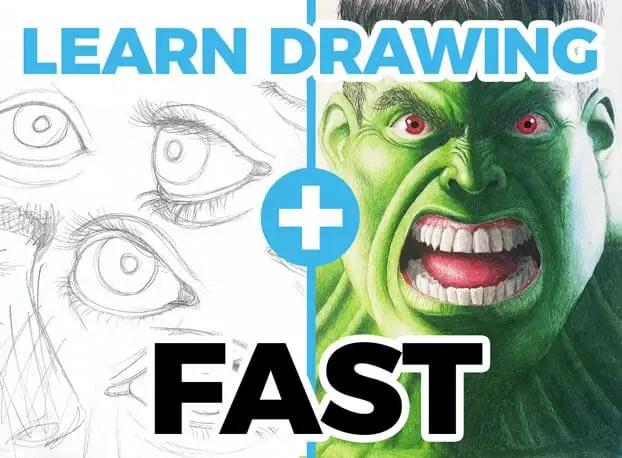
To learn drawing fast you have to draw daily and put in a lot of hours. Instead of drawing random things, you need to do focused practice sessions that work on your weak points. Having a clear strategy is the quickest route to learn drawing fast.
There are three types of practice, when it comes to drawing.
What I’m alluding to aren’t the specific areas you should study while practicing your art – like anatomy, perspective, lighting, etc.
You can read about those things in detail in my guide on how to draw anything.
What I’m talking about are three general approaches to practicing:
1. Inherent Practice
2. Dedicated Practice
3. Field Practice
As you’ll see, all of these methods have merit and none is by itself better than the other.
Let’s look at them in detail:
» Learn Drawing Quickly With These High-Quality Courses
2.1 Inherent Practice
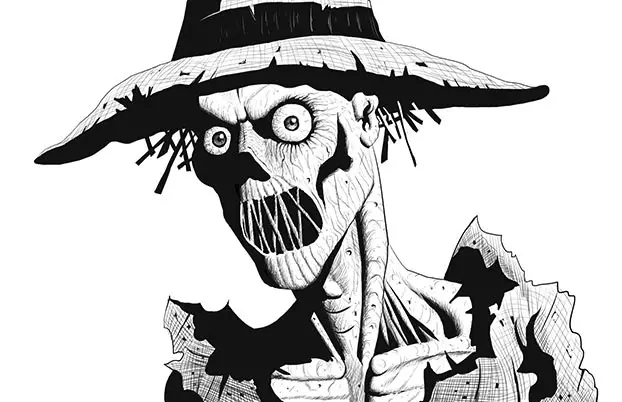
Inherent practice is the type of practice you do automatically.
Every time you put a pencil on paper to draw something you get better.
One line at a time.
Even if your goal wasn’t to get better at drawing … if you just wanted to have some fun doodling around, you would still improve over time.
That’s the power of inherent practice.
It’s pretty much passive practice. You do it anyway, even if it’s not purposeful.
To learn drawing fast, you need more active approaches though.
RELATED: Can You Learn To Draw?
2.2 Dedicated Practice
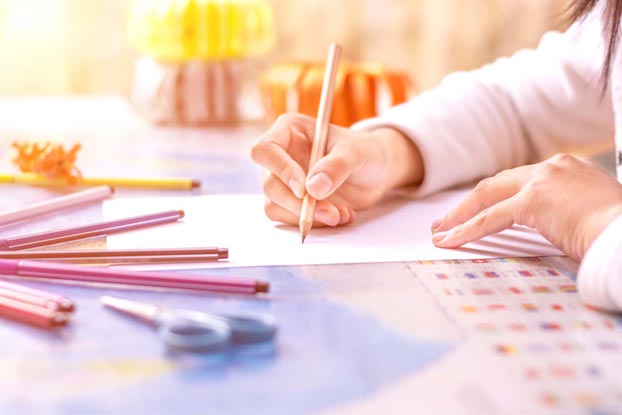
Dedicated practice is when you devote a specific amount of time to learning how to draw or paint one specific thing in particular.
So let’s say you want to learn how to draw heads.
Dedicated practice would mean that you sit down and just draw heads (and heads and heads…) for a while – and nothing else. The extent of your dedication is measured by how many heads you draw.
You can dive deeper though.
If you’re trying to draw heads, you will obviously need to be able to draw its features: The eyes, the nose, the lips, the ears… That means you would sit down and draw lots of those elements in different perspectives, too.
For example, here are two pages like that I did in 2018 when I was trying to do just that: learn how to draw faces.
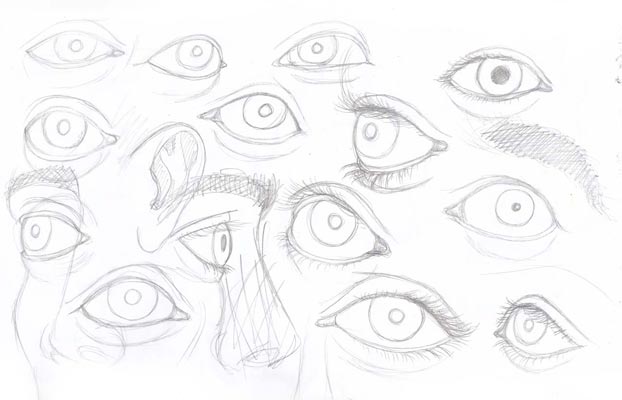
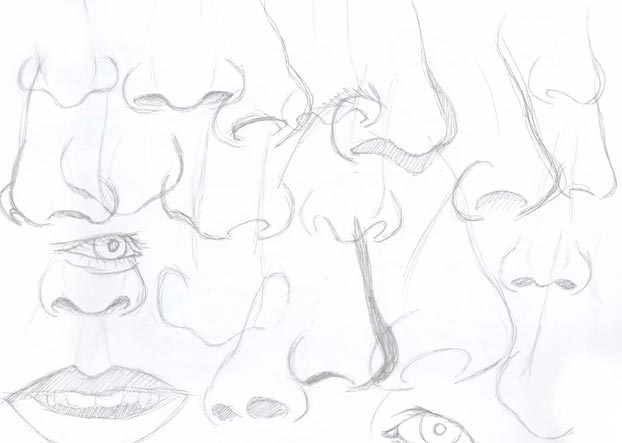
If you take this approach to the extreme, you can do something like Todd McFarlane describes in the video below (starts at 1:24):
Todd McFarlane is the creator of Spawn, if you didn’t know that already. He’s a super talented comic artist and an all-around great guy.
In his early days, he was basically SUPER dedicated and learned to draw the human body piece by piece. He sat down and only drew forearms for a week. The next week he would draw upper arms etc.
It’s a tedious process, but it obviously paid off in spades for him in the end.
If you’re wondering what you should practice first, check out my beginner artist guide.
Dedicated Practice – Pros & Cons

- it makes you good fast
- it builds your visual library
- improvement is often more noticeable which makes you feel like you achieved something and really got better

- it can be boring
- can feel like something you have to do instead of something you really want to do
2.3 Field Practice
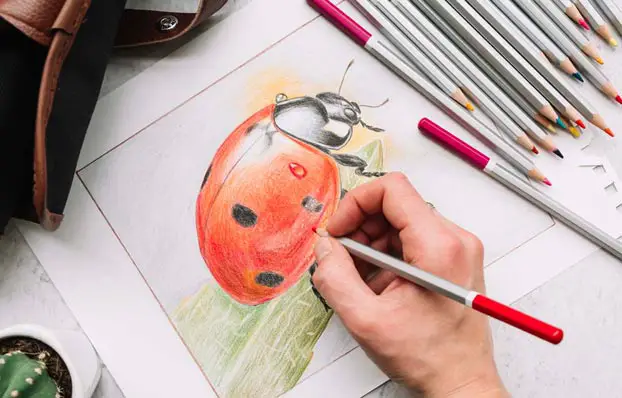
The third way to practice your craft is what I personally call field practice.
Instead of doing page after page of committed disciplined practice drawings, you practice “in the field”:
You finish personal drawing projects – big projects that take a lot of hours and perseverance.
While doing this takes away precious time you could use for dedicated practice, finishing projects teaches you lots of things, too.
In the end, that’s what you probably want to do as an artist anyway:
Draw and paint beautiful pictures! If you plan, execute and finish big projects, you are basically learning by doing – doing what you want to be able to do in the end anyway.
CHECK OUT: 6 Characteristics Of Good Art – What Makes A Drawing Good?
One caveat though:
There’s a right and a wrong way to approach this.
If you just go at it and create finished pictures at your current skill level, you won’t really improve much. The trick is to
a) draw projects that push yourself
and
b) purposefully practice the specific pieces you need to be able to draw that image.
That means that if you were trying to draw a picture of Batman punching the Joker (who wouldn’t want to draw that?), you would do some practice pages beforehand.
CHECK OUT: 30 Quick And Easy Drawing Tips To Boost Your Progress
But instead of just practicing eyes or something, you would practice exactly what you need to be able to draw:
- Batman in a certain pose and from a certain perspective
- his clenched fist
- Joker’s face and expression while getting punched
- etc.
This way you also learn a lot. It’s essentially the same method as the first one, but you practice in a more deliberate way – by drawing exactly what you need to learn for a specific project.
Draw enough of those and you’ll probably be a pretty amazing artist, too.
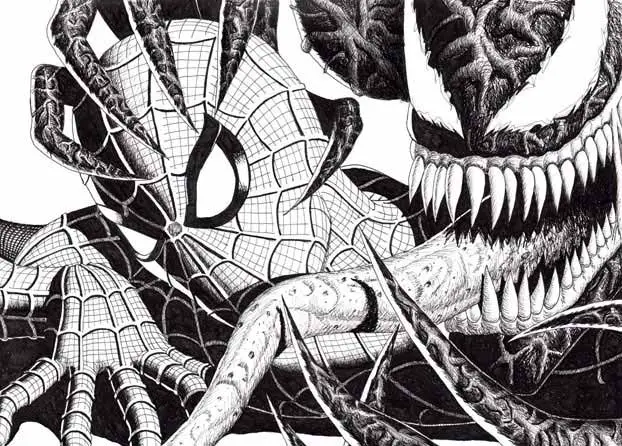
For example, this is a finished drawing I did last year. It took me over 10 hours to complete – time I could have used for dedicated practice. I’m happy I drew this though and am proud of it. And I still learned a lot! You can watch the whole drawing process here.
Field Practice – Pros & Cons

- is often more fun than dedicated practice
- adds more variety to your practice
- leads to finished pictures you can be proud of instead of throwaway practice pages
- might make you a more well-rounded artist because you might practice stuff that you otherwise wouldn’t practice

- it may take longer to get good in general
- it lacks focus – you’re not getting really good at drawing a specific thing very quickly
- the positive effects may not last because you don’t repeat what you learned regularly (if you draw a lot of very different pictures)
Improve Faster With My FREE e-Book!
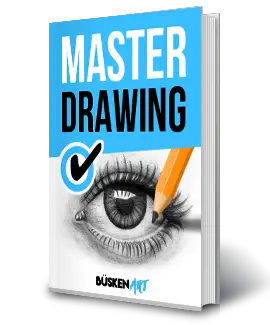
Learn how to MASTER drawing in 5 easy steps with my FREE PDF guide!
Discover a methodical way to learn drawing effectively!
Conclusion – How You Should Practice Drawing And Painting
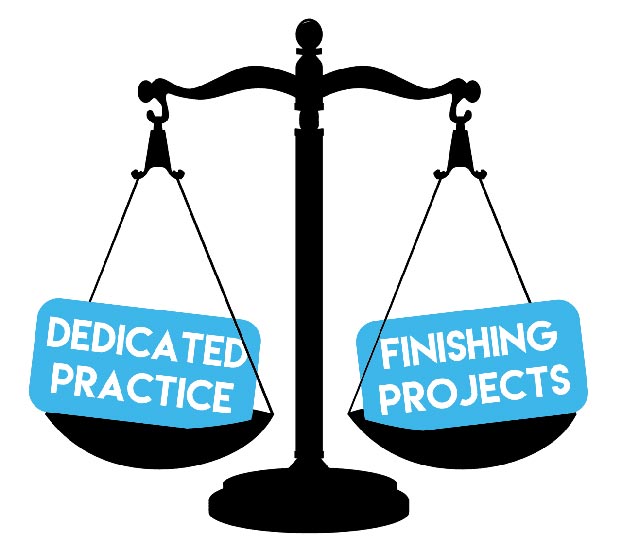
You probably guessed it. Like I already said at the beginning:
None of those approaches is the best. All of them have merit.
And while it may seem that based on the pros and cons I listed I prefer field practice, I still understand that regular dedicated practice is necessary, if you want to be the best artist you can be.
If you just draw finished pictures, you will learn a lot, but you probably won’t get better as quickly as you could.
If you just practice deliberately though, you will probably get bored quickly and end up not having anything to show for it apart from some random practice pages. No finished pictures whatsoever.
The solution is to do them all: Paint your finished pictures, but every now and then allot some time to dedicated practice.
That way you will get the best of both worlds:
You will get better quickly, but you will have fun doing it and also create some (hopefully) stunning pieces of work to put out in the world.
Now go practice!
-Daniel
P.S.: Just to let you know: I have a YouTube channel, too. I’d appreciate it if you check it out!
READ NEXT:
30 Best Art Tips & Tricks For Beginners [And Beyond]

thank you for this. it’s just what I needed. I love how human this is too.
I’m really motivated! thanks!!
Great! I’m always happy to help, Matt! 🙂 Motivation can be a fickle thing, so great that you have it.